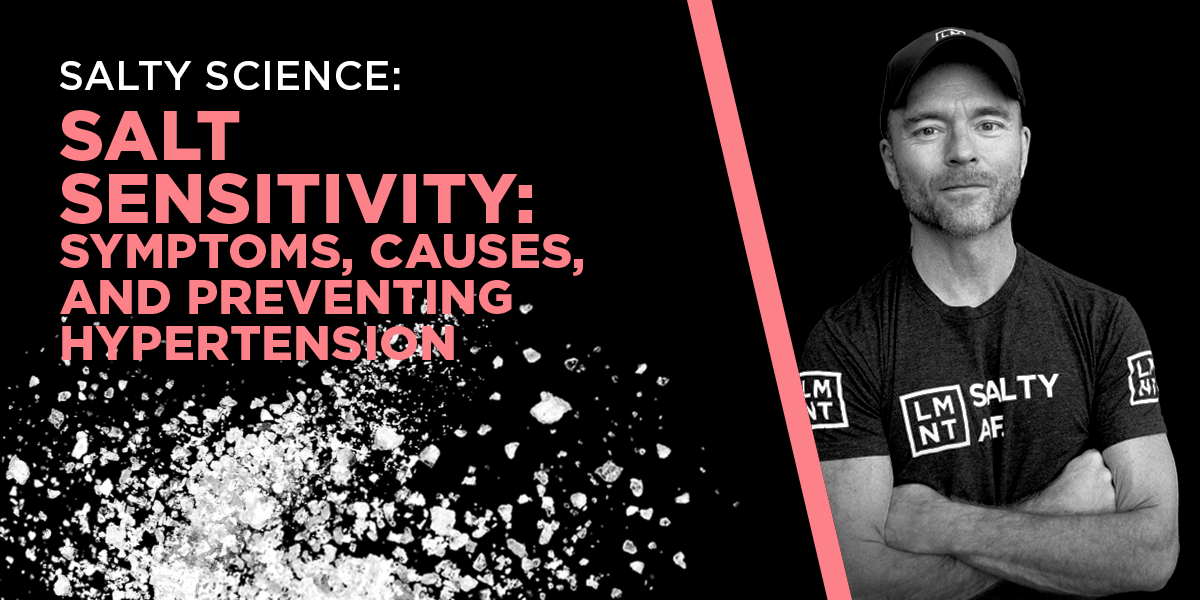I recently received a note from an LMNT customer who was concerned about salt sensitivity. Genetic testing had revealed several SNPs (genetic variations) that predisposed him to this condition.
Salt sensitivity is a condition in which people see a material increase in blood pressure after consuming even moderate amounts of sodium. Since high blood pressure is a well-established risk factor for heart disease, this can be worrisome. But untangling salt sensitivity is complicated. Just because someone has a certain genetic predisposition or even hypertension doesn’t necessarily mean they should stop salting their food. It’s possible to be salt-sensitive, hypertensive, and low on sodium.
That said, I speculate that many cases of salt sensitivity could be resolved by simply addressing underlying metabolic issues. And oftentimes increasing potassium intake can make a meaningful impact for hypertensives too. Higher potassium intakes are uncontroversially linked to lower blood pressure, and potassium supplementation seems especially effective in salt-sensitive folks.
I’m not saying that salt sensitivity is bogus. It’s real, and some folks should limit sodium to keep blood pressure within healthy ranges while they work on improving their metabolic syndrome with a healthy whole foods diet and exercise. Today I’ll cover sodium, blood pressure, and salt sensitivity in depth. By the end, I think you’ll be better positioned to calibrate your sodium intake.
Sodium and Blood Pressure
Sodium is a key regulator of blood volume and, by extension, blood pressure. In other words, sodium helps blood get to the right places to deliver oxygen, nutrients, immune factors, and other good stuff.
If a healthy person consumes a decent bolus of sodium, blood pressure will transiently rise. This small increase may last 20 to 30 minutes as the kidneys work to excrete the excess sodium. Then blood pressure will normalize.
If you inject rats with supra-physiologic levels of sodium, the spike in blood pressure will be more pronounced. That’s what a researcher named Lewis Dahl did back in the 1960s, and it’s now the basis—along with some unconvincing epidemiology—for the US recommending a low sodium diet.
The promise was that a low sodium diet would effectively prevent the high blood pressure condition known in medical circles as hypertension. Has this promise been fulfilled?
On a large scale, it hasn’t. The massive INTERSALT study, for instance, found that sodium intakes were NOT linked to rates of hypertension in 48 of 52 global populations.
If that data doesn’t convince you, consider a more recent analysis of 2,632 people with normal blood pressure. Those restricting sodium in line with government recommendations (under 2.5 grams per day) had HIGHER blood pressures than those consuming over 2.5 grams per day.
So in the general population, limiting sodium to prevent hypertension makes little sense. But what about in salt-sensitive folks?
What Is Salt Sensitivity?
Salt sensitivity (also called salt sensitivity of blood pressure) describes an increased sensitivity of someone’s blood pressure to salt consumption. Technically, a person is considered salt-sensitive when they have at least a 5 mmHg rise in blood pressure in response to a change in salt intake.
Salt sensitivity is correlated with hypertension, which is concerning because high blood pressure is a well-documented risk factor for both heart attack and stroke. Hypertension is also a risk factor for dementia since high blood pressure damages the delicate microvessels of the brain.
About one-third of Americans suffer from hypertension. Most cases are considered “essential” hypertension, which is a polite euphemism for “we don’t know what the heck causes it”.
When it comes to placing blame for hypertension, sodium (a chief component of salt) is a popular whipping boy. But as you’ll recall, the evidence doesn’t support this.
Let’s come back to salt sensitivity though. According to the blood pressure criteria, around a quarter of normotensive people and upwards of half of hypertensive people are salt-sensitive.
But drawing sweeping anti-sodium conclusions from this data is problematic. Just because hypertensive people tend to be more salt-sensitive doesn’t mean that salt is to blame. Correlation is not causation.
Height, for instance, is positivity correlated with reading ability. As height increases, reading ability increases.
Should we conclude that taller people are better readers? (Sorry Danny DeVito!). Please don’t conclude that. The data is merely skewed by the fact that babies and toddlers can’t read Tolstoy.
With this in mind, let’s look at some of the factors correlated with salt sensitivity.
Factors Underlying Salt Sensitivity
Salt sensitivity doesn’t have one cause but rather is influenced by multiple factors. I’ll list the main ones.
#1: Kidney issues
Thanks to the kidneys and a slew of hormones called the renin-angiotensin system, most people are well-equipped to dispose of excess sodium. But not everyone.
Those with chronic kidney disease, for example, aren’t able to clear sodium properly. And since African Americans are nearly four times more likely than white Americans to develop kidney disease, they’re also more likely to be salt-sensitive.
Even in the absence of kidney disease, salt-sensitive people may have impaired sodium disposal. The mechanism appears to involve over-stimulation of the sympathetic nervous system and over-release of sodium retention hormones like aldosterone, epinephrine, and norepinephrine.
Researchers have also identified a handful of genetic mutations (SNPs) that impair renal clearance of sodium. For instance, the guy who wrote me was dealing with an undesirable mutation in the SLC4A5 (sodium-bicarbonate cotransporter 4) gene.
#2: Insulin resistance
Salt sensitivity has also been linked to insulin resistance. (Insulin resistance refers to the inability of the hormone insulin to properly regulate blood glucose levels). The topic of insulin resistance is a whopper, and I won’t be able to do it justice here. For now, I’ll just say that this diet and lifestyle driven metabolic issue is at the center of the “diabesity” crisis plaguing America.
Anecdotally, I’ve noticed that salt-sensitive folks tend to be insulin resistant. Because of this, I believe many cases of salt sensitivity could be resolved by making diet and lifestyle mods (keto diet, intermittent fasting, more exercise, etc.) to promote better metabolic health. And that position is not all anecdote. There is research to suggest sodium sensitivity and a tendency towards insulin resistance go hand in glove.
#3: Endothelial dysfunction
Sodium retention doesn’t just happen in the kidneys and internal tissues. Researchers have found, for instance, that people with hypertension and chronic disease have more sodium in their skin than healthy people.
The explanation involves the endothelium. Salt-sensitive people tend to produce less nitric oxide (a compound that dilates blood vessels and lowers blood pressure) in this thin layer of cells facing the bloodstream. More research is needed, however, to untangle the complex interaction between skin sodium, blood pressure, and salt sensitivity.
#4: Insufficient potassium
If you don’t get enough potassium, your blood pressure will notice. This mineral is an uncontroversial blood pressure reducer.
Potassium balances sodium’s effects on blood pressure. When salt-sensitive people consume enough potassium it mitigates blood pressure spikes even at high sodium intakes. “Enough” is a subjective term, but based on our best data, I recommend between 3.5 and 5 grams daily.
I hypothesize that potassium insufficiency (at least partly) explains the observational data linking higher sodium intakes to hypertension. The modern diet is high in sodium—yes—but it’s also devoid of fruits, vegetables, and other potassium-rich foods. Sodium gets blamed, but should we be blaming a lack of potassium instead?
Symptoms of Salt Sensitivity vs Symptoms of Low Sodium
The hallmark of salt sensitivity is a blood pressure bump upon salt intake. Salt-sensitive people will also tend to see increased fluid retention because they aren’t efficiently excreting sodium.
Consuming too much sodium can also lead to excessive thirst and an increased frequency of urination. These mechanisms help your body restore sodium levels to normal ranges.
The symptoms of low sodium are more related to energy, mood, neurological function, and exercise performance. They include:
- Headaches
- Irritability
- Muscle cramps
- Confusion
- Dizziness
- Brain fog
- Swelling of the hands
- Weakness
- Lethargy
If any of these symptoms are present, it probably makes sense to increase sodium intake.
How To Calibrate Sodium Intake
Sodium needs are highly individual. They depend not only on salt sensitivity genes, but also on sweat volume, diet, altitude, and a host of other factors.
A good baseline is 4–6 grams of daily sodium (2–3 teaspoons of salt), but many people will need more. We’ve worked with NHL teams who report that their larger athletes lose up to 10 grams of sodium during a game!
I recommend a two-pronged approach for calibrating sodium intake:
- Check that you’re not short on sodium
- Check that you don’t consume too much sodium
The first piece means looking out for low sodium symptoms (listed above) and tweaking your sodium intake accordingly. The best way to do this is by trial and error until the symptoms dissipate. (I recommend LMNT for a tasty way to add a gram or two).
The second piece is to monitor blood pressure and water retention so you don’t overshoot the sodium mark. This can be tricky since most people (even non-salt-sensitive folks) will see a mild, transient increase in blood pressure after consuming a gram or two of sodium.
You need to consider the whole picture. Salt-sensitive or not, if you spend most of your time lounging in a climate-controlled room, you’ll have to worry about excess sodium more than a sweaty athlete. If your lifestyle changes, your sodium needs tend to change with it.

